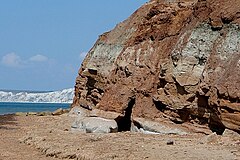| Wessex Formation | |
|---|---|
| Stratigraphic range: | |
 Exposure of the Wessex Formation west of Chilton Chine | |
| Type | Geological formation |
| Unit of | Wealden Group |
| Sub-units | Coarse Quartz Grit (in Dorset) |
| Underlies | Vectis Formation |
| Overlies | Durlston Formation |
| Thickness | up to 1000 m near Swanage |
| Lithology | |
| Primary | mudstone |
| Other | sandstone, ironstone & conglomerate |
| Location | |
| Region | Southern England |
| Country | |
| Extent | Dorset, Isle of Wight, offshore Wessex Basin |
| Type section | |
| Named for | Wessex |
| Named by | Daley and Stewart |
| Location | Bacon Hole, Mupe Bay |
| Year defined | 1979 |
 Exposure of the Wessex and Vectis Formations on the South Coast of the Isle of Wight, shown in turquoise. | |

The Wessex Formation is a fossil-rich English geological formation that dates from the Berriasian to Barremian stages of the Early Cretaceous. It forms part of the Wealden Group and underlies the younger Vectis Formation and overlies the Durlston Formation.[1] The dominant lithology of this unit is mudstone with some interbedded sandstones. It is part of the strata of the Wessex Basin, exposed in both the Isle of Purbeck and the Isle of Wight. While the Purbeck sections are largely barren of vertebrate remains, the Isle of Wight sections are well known for producing the richest and most diverse fauna in Early Cretaceous Europe.
- ^ "Wessex Formation". The BGS Lexicon of Named Rock Units. British Geological Survey.